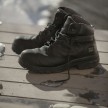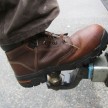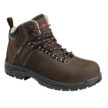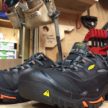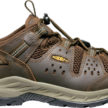Timberland PRO Radius Composite Toe Work Sneaker
Timberland PRO Radius Composite Toe Work Sneaker
The Timberland PRO Radius Composite Toe Work Sneaker, part of Timberland’s Pro series of work gear, is a great example of what modern technology can bring to the shop or jobsite. It’s comfortable like a sneaker, but stable and with safety features like a work boot. Before I dive into it specifically, let’s take a minute and look at where a work sneaker — or low-cut work boot — is appropriate compared to a higher-rise work boot.
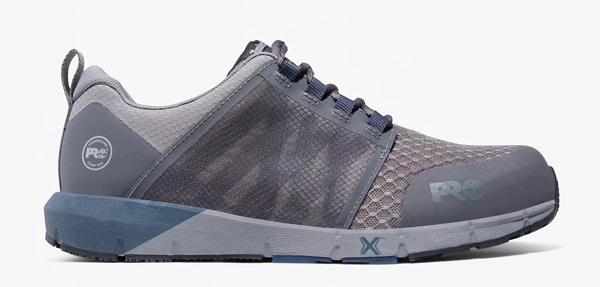
Advantages of low shoes/boots
A low shoe will provide more flexibility and less constriction of the foot’s motion. It has less of a “clomping” feel to it. Its lighter weight and somewhat smaller footprint make it easier for you to get up and down repeatedly from a standing to a prone position. And a shoe that doesn’t cover your ankles provides greater feedback – proprioception – when you are on unstable or uneven surfaces such as a roof. (Many hikers prefer low-cut hiking shoes over boots for this reason, among others).
I prefer a low-cut work shoe when I’m working in a reasonably finished space. This obviously incuses a finished house or office, but also one that’s mostly finished—say, drywall up and sub floors down. Also on roofs; I very much want a low-cut shoe when working on roofs.
Advantages of high(er) cut work boots
It’s a myth that higher boots provide more ankle protection if by “protection” you mean protection from twists and sprains. What they do provide though is protection from abrasion and bruising. And much like a brace, they do provide support to all the small muscles that work in conjunction with the ankle, meaning that you might get less fatigued on your feet all day wearing them. Finally, higher boots certainly provide extra inches of water-intrusion protection
I prefer higher (6- or 8-inch) work boots when working outdoors, particularly in gravel or wet environments, or on moderately uneven surfaces where my ankles have to work hard to stay stable.
Low work boots compared to regular sneakers
Some tradies – I’ve seen it mostly with painters, finish carpenters, and drywallers – simply wear regular sneakers on interior jobs. I think this is an accident waiting to happen. For one, regular sneakers don’t have any safety features, such a slip-resistance, puncture-resistance, safety toes, etc. Second, they don’t provide lateral stability; I’ve tripped and fallen wearing them when moving sideways because of it. Third, they don’t have a rigid shank, and using them while on ladders is both very uncomfortable, and not good for your feet. The law of large numbers is at work here. You can get away wearing sneakers on a onesy-twosy basis, but of you do it day-in/day-out it becomes “when”, not “if”, these things will catch up with you. Use the right tool for the job.

Timberland PRO Radius Composite Toe Work Sneaker
The Timberland PRO Radius Composite Toe Work Sneaker is a work shoe that looks like a sneaker, but on the foot feels like a hybrid of a sneaker and a traditional work shoe. That is, it has the comfort and flexibility of a sneaker, but the solid, stable feel of a work shoe…and of course a host of safety features. Specs:
- Breathable, durable mesh upper with abrasion-resistant reinforcements
- Asymmetrical composite safety toe
- Metal and mutilation free
- Timberland PRO® Flex Technology outsole featuring anatomically positioned flex grooves
- Mark II oily wet #3 on American Olean tile at .55
- Lightweight, fuel- and oil-resistant Hover Spring™ foam midsole for industry-leading underfoot comfort, flexibility, and durability
- Anti-Fatigue Technology polyurethane footbed for shock absorption and energy return
- Breathable and moisture-wicking lining with antimicrobial treatment for odor control
- Cement construction for flexibility
- Electrical hazard protection
- 30-Day comfort guarantee
- $115 MSRP
This work sneaker flexes easily at the rear of the ball of the foot (not at the arch), so it won’t compromise arch support. On the foot it is very, very comfortable, and yet it also feels very stable and secure. It really is aptly named a work sneaker!

In the field
I wore this work sneaker for just about everything: general shop work (lots of standing), mowing the lawn (lots of walking), heavier framing work (lateral ankle loads), walking the dogs for a couple of miles in the woods every day (uneven ground), and just around town doing chores. The roots and rocks in the woods weren’t uncomfortable to walk on. The Timberland PRO Radius Composite Toe Work Sneakers were as comfortable as my general knock-around shoes and as stable as a pair of low boots. I was seriously impressed!
I was even more impressed by the fact that they fit my weirdly narrow feet. While they are a standard medium (“D”) width, they could also be laced snugly (and comfortably) enough that they felt fine and my heels didn’t slip.
One seemingly little detail that would otherwise be aggravating is that the laces pull tight along their entire length with a single pull on the loose ends. Too many work shoes have laces that “stick” in the eyelets, requiring you to tighten or loosen them at many points when taking off or putting on the shoe. A small feature, but one that I really appreciate.

Where they fit (bad pun!)
These are the shoes that I will use for most of my shop and interior work. Their light weight makes it easy to pop up and down from standing to prone and back, and they are very easy on/off. Where wouldn’t I use them? Probably outdoors where I was worried about water intruding in over the tops of my shoes, or in moderately unstable environments where I would appreciate the support of a higher boot (think setting foundation forms below grade). The fact is that finding a pair of work shoes that you love for interior or conditioned space work is at least as hard as finding a pair you love for the more rugged outdoor work.
The Timberland PRO Radius Composite Toe Work Sneaker would be an excellent choice for shop work of any kind: wood shops, machine shops, manufacturing floors, etc.
And a slip-on version
The Timberland PRO Radius Composite Toe Work Sneaker just got a sibling this year: the Timberland PRO Radius Knit Composite Toe Work Slip-On Shoe. This is essentially the same shoe but in a slip-on version (not exactly the same, but with relatively minor differences). As suited as the Radius is to shop work, I’d think that this slip-on version would add a lot of convenience to its already outstanding suitability for that environment. The only contra-indication here is that if you have very narrow feet as I do, then your heel may slip a bit in the Radius Knit.

Bottom line
When Timberland asked me to look at the Radius, I wasn’t sure what to expect. But it’s become probably my favorite interior/shop work shoe. Comfortable like a sneaker, protective like a work shoe. We’ve come a long way from the work shoes that were available when I started out. I recommend these.



